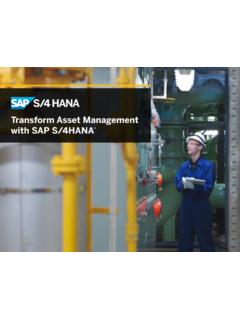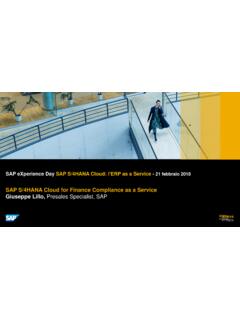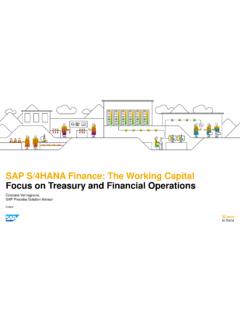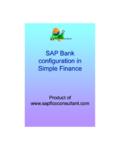Transcription of 1. What is SAP S/4HANA? - Adapt IT
1 1. what is SAP S/4 HANA? SAP S/4 HANA is the next-generation go-to Business Suite tool for SAP. Only available on SAP HANA database, SAP S/4 HANA covers the majority of the functionality that was previously available within SAP ECC. The concept behind S/4 HANA is to produce a simplified Business Suite that runs on HANA with an SAP Fiori front-end and real-time analytics. The underlying table structure has been re-written to provide a simplified data model to increase performance, simplify reporting and reduce the overall size of the system. Deployment Options: On-premise or in the cloud, the choice is yours S/4 HANA can be deployed on-premise or in the cloud, depending on your individual needs and requirements. The on-premise version gives you high degrees of control and flexibility, whilst the cloud version is quicker to deploy with a lower total cost of ownership. Versions There are two current versions within S/4 HANA with a different scope: SAP S/4 HANA finance is based on the core ECC solution.
2 The finance modules, tables and processes have been simplified whilst the remaining areas have been untouched. Additional new functionality has been released within the finance space. SAP S/4 HANA Enterprise Management has a wider scope, with Materials Management and Operations simplified as well as finance . A number of new functionalities have been released and many traditional modules have been removed. With the aim to run simple , SAP has a paradigm of the principle of one where there will be only one module or process for a particular area, rather than the few that were traditionally available within ECC. Industry-specific functionality will be added to S/4 HANA over time as it evolves. 2. Why SAP S/4 HANA? SAP S/4 HANA has been created to enable your business to transform. Processes run quicker, real-time analytics allow for more accurate decision-making, and there is an improved user experience for your teams.
3 Business transformation SAP S/4 HANA is designed to provide business transformation for your organisation. This transformation may be subtle or very dramatic. Each organisation will approach S/4 HANA from a different baseline, with different objectives and therefore there is not a single set of motives to move to S/4 HANA. Simplified data model One of the core concepts of S/4 HANA is the change in which data is held within it. The new data models will significantly reduce the size of the database which in turn will lead to performance benefits and hardware cost reductions. The new data model will allow processes to be performed in a less complex manner and reporting can be simplified as all of the data is now in a reduced number of tables. Improved user experience SAP Fiori is available within S/4 HANA to improve your users experience. Fiori reduces the volume of key strokes that are required to perform a transaction.
4 This in turn frees up your users time to add value elsewhere. Fiori is also more intuitive therefore training and testing costs will be less than those associated with a traditional SAP ECC solution. Real-time analytics Embedded analytics provides a world of opportunities for organisations. Gone are the days of extracting data from ECC into SAP BW, and then transforming the data to meet reporting requirements. Real-time reporting is now available directly from S/4 HANA. This simplified approach leads to enhanced decision making, using relevant data. In turn, the speed and functionality of SAP HANA removes the need to utilise offline methods to generate reports and employ analytical tools. SAP HANA SAP HANA as a database provides unrivalled speed and performance which enables jobs and transactions to run in a more acceptable timeframe. The predictive engine within HANA provides new ways to work by automating complex calculations and improving the accuracy around decision making.
5 Combining all of these four key areas in a process will provide significant benefits to your organisation. 3. How to get to SAP S/4 HANA Finding the right path for you in your journey to SAP S/4 HANA. Part of the decision-making process in moving to SAP S/4 HANA needs to be how . what is the right journey for you to take to S/4 HANA? As it is a new product, the steps and processes to its implementation are different to a typical solution upgrade. a. System conversion This takes your current SAP ECC solution, provides a database change to SAP HANA, assuming you are not already on Suite on HANA, and then converts the data and functionality into the new S/4 HANA. Your custom code needs to be checked to confirm it will work on the HANA database, and with the new data models and processes within S/4 HANA. The traditional ECC table base needs to be converted into the new simplified data models. Functionality that has been removed from your existing ECC system needs to be either replaced or converted into the new solution.
6 This option is most attractive if you have a reasonably clean ECC environment, do not want to apply additional functionality within S/4 HANA and have a reasonable downtime window. This option is least attractive if you have a complex environment with a significant amount of unused data and code, with a requirement to install new functionality and have a tight downtime window. b. New Install Rather than keep all of your old and unused custom code, and in some cases data, a new install is a way of providing a clean landscape to grow from. Relevant customisations will need to be applied to the new solution. All relevant data will need to be migrated. SAP Activate can be used to manage the project and the guided configuration tool can be used if required. There is also the ability to base your configuration on SAP Best Practice to ensure you stay close to standard SAP. You have the ability to add all of the required new functionality in the initial release.
7 This option is most attractive to an organisation who has a complex environment with plenty of unused data and code, with a requirement to install new functionality and has a tight downtime window. This option is least attractive to an organisation who has a pretty clean ECC environment, does not want to apply additional functionality within S/4 HANA and has a reasonable downtime window. c. Landscape optimisation You may have more than one ECC environment to manage your global requirements. S/4 HANA can be used as the vehicle to consolidate these environments into a single one. When you have more than one SAP ERP system you have the flexibility to do things in different ways. The downside is that when you want to provide a single global view for reporting it becomes difficult to achieve. S/4 HANA can be used to link to your current ERP systems (SAP and non-SAP) and provide a consolidated environment to manage your financial data.
8 This is referred to as the Central finance option. There is also the ability for you to create a new S/4 HANA environment and start to run combined processes from a single system. This will provide you with significant cost saving in terms of support and maintenance, however all divisions would need to follow the central patching strategy. This option can only be used if you have more than one ERP environment. There will need to be a compelling business case to consolidate the ERP environments as you could still use either option 1 or 2 to move to S/4 HANA for each of their separate ECC systems. d. Roadmap to SAP S/4 HANA Helping you to understand the key influencers when moving away from SAP ECC and what the right endpoint is for your organisation. SAP S/4 HANA is the current end state for those of you using the SAP ECC6 Business Suite, so plans need to be made as to what is the best route for you. Every organisation is different in terms of size, complexity and focus, meaning that there is not a common approach.
9 There are various options available to you when you choose to move to S/4 HANA. These include moving to SAP Suite on HANA and also considering the two different on-premise S/4 HANA versions ( finance and Enterprise Management). what will influence your journey to S/4 HANA? When designing your roadmap to S/4 HANA these three areas will influence the route you take: Business involvement Your organisation s strategic objectives will determine where its focus is going to be. If the current ECC solution is blocking some of these objectives, or conversely, functionality within S/4 HANA can enable one or more of them, then providing business resources will be easier to achieve. There will also be occasions where the business change achieved by moving to S/4 HANA is required, but not for a few years. In these situations, moving from ECC to Suite on HANA may feel like a sensible approach for you to take. The introduction to SAP HANA with a mainly technical focused project will shield the business from a more significant undertaking whilst providing some initial benefits.
10 Solution fit The S/4 HANA solution that is currently available is not fully complete. New processes are being designed, new functionality released and Industry Specific solutions are aligning to the S/4 HANA design principles. There are currently a couple of thousand SAP transaction codes that no longer work within S/4 HANA from SAP ECC and new functionality has been added. As it stands today moving to SAP S/4 HANA Enterprise Management is not achievable for everyone, however you could move to SAP S/4 HANA finance . A clear understanding of how your existing ECC environment works is needed to provide a detailed review of the current scope of S/4 HANA. This will identify gaps and changes that would be required. Some of these may be show stoppers, halting any move to S/4 HANA. However, for some parts of the new functionality within S/4 HANA will add considerable benefits. Appetite for disruption Making such a significant move to S/4 HANA will create disruption to your organisation, however disruption can be positive.










